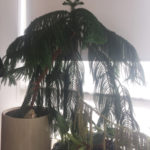Hi, I have had a beloved Norfolk pine in my home since 1999. For the past 12 years, it has been on the windowsill of a south-facing window. The window has a translucent blind that cuts the strength of the sun on the tree. I re-potted the tree about 4-years ago. It stands about 3′ tall, though it has a pronounced curve along its trunk. Over the past year, it has started to have problems–dropping lower branches at a rate it never has before. I worried I was overwatering it, and pulled back on that. I have more recently taken to misting it regularly. It has lost many of its lower branches, and is looking rather sad. It seems to be threatening to drop more branches soon. I am wondering if I should start fertilising it? Perhaps giving it more light? Less light? I am not sure what to do, and am really saddened by what’s happening! Please help!!!
Thank you for contacting the Toronto Master Gardeners.
Branches, needles or branch tips falling off Norfolk pine is a regular occurrence with these plants, even when conditions are ideal. As Norfolk Island pines grow, they may shed a few needles or even entire lower branches – this type of loss is natural, however widespread branch drop in Norfolk pines is usually caused by incorrect growing conditions. Low humidity, improper fertilization and improper watering are the typical culprits
When caring for indoor plants whether they are tropicals, catci, succulents, or Norfolk Island pines, understanding the native environment of the plant in question helps ensure success. In their native environment Norfolks grow in well drained soil rocky sandy soil and full sun.
Tropical plants prefer to be in a south-facing window which receives several hours of direct, bright light, if this is not possible they will also tolerate full indirect, bright light as well.
Normal indoor temperatures are fine for this plant just take care not to place your plant near drafty areas or heating /cooling ducts. If you need to reposition your plant make sure to do this gradually so that the plant becomes accostumed to its new location. Failing to do this may result in it dropping it’s lower branches.
Water your Norfolk Island pine whenever the soil feels dry to the touch, and always empty the saucer. If the soil pulls away from the pot’s edge as it dries, gently press it back in place with your thumb. This keeps water headed toward roots instead of running down the pot’s sides.
If your home’s humidity runs below 50 percent, your plant will appreciate a boost. Mist it regularly using a spray bottle, or place a pebble-filled saucer beneath it. Add water to the saucer, but keep the water level below the top of the pebbles, so the bottom of the pot stays dry. A home humidifier also works well.
Make sure to fertilize your plant every six weeks during the active growing season from spring until fall using a liquid 20-20-20 fertilizer make sure to follow instructions on the label for proper dilution.
The root system of Norfolk pines is slow growing and as a result repotting is not required until roots peek through the container’s bottom. When repotting time comes, choose a deep container with good drainage holes, and then fill it with coarse, fast-draining potting mix, a soil used for cacti will work well.
Good Luck.


